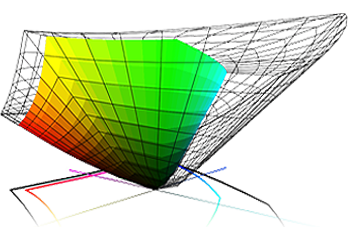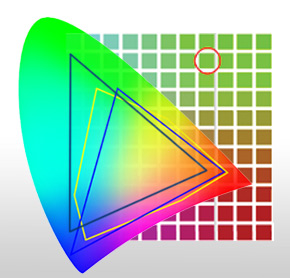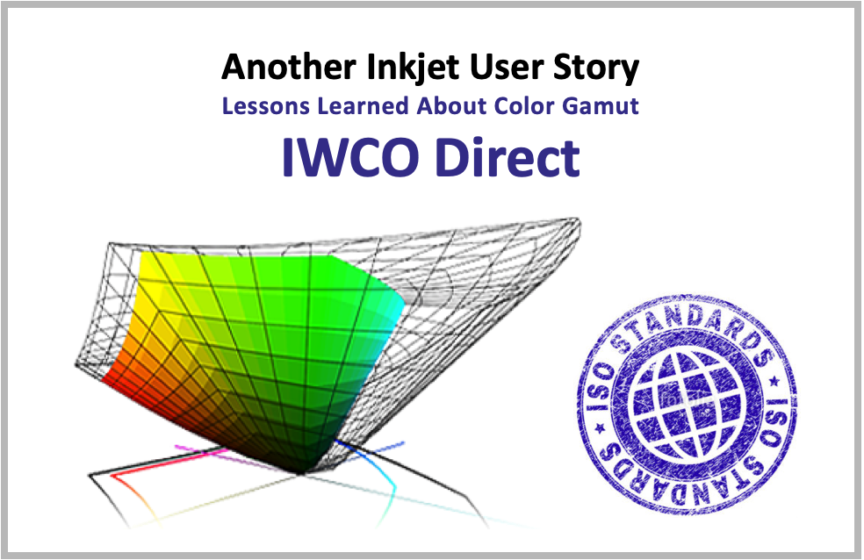You don’t need to be in the industry very long before the topic of color gamut comes up. Different print technology vendors will talk about it, compare it, and brag about it like boys bragging about baseball cards back in the day. “We can print more colors.” “We can better match Pantone.” “Look at our saturation.” The statements go on and on. But, what do we really mean by color gamut? What are the important things to know when talking about color gamut? What are some of the factors that affect color gamut in production inkjet?
Whether you are a Print Services Provider or a buyer of inkjet-printed products, these color gamut questions matter. At IWCO Direct, we spend a lot of time answering these questions. Here are some of the things we’ve learned thus far.

What do we Mean by “Color Gamut?”
In its simplest form, color gamut is the amount or range of colors that a print technology can print. Unfortunately, the simple answer doesn’t tell the whole story. There are a wide range of factors that can affect a print technology’s color gamut, including ink, substrate, and run speed. Let’s review some of the main factors that impact color gamut and production inkjet to better understand it.
Applying Color Space Standards
If you have just one print technology, your main goal is probably to just have the largest color gamut possible. As soon as you start adding other print technologies, shared appearance across all platforms becomes more important. That is where print standards and G7 can become a big help.
G7 Methodology
Whether you are printing across multiple print technologies or not, targeting G7 is an excellent way to maintain consistent color. Depending on the print technology and its ability to accept tone curves or not, you can sometimes expand your color gamut while maintaining the natural look of flesh tones and grays. G7’s methodology is critical in helping maintain a shared neutral appearance across multiple technologies. IWCO Direct is a G7 Master Colorspace service provider across all print technologies and locations. And while we appreciate the certificates, the main reason we target G7 is because of greater color consistency across our print technologies.

Print Conditions
ISO 15339 established seven G7-based “Reference Print Conditions” (i.e. color gamuts) to cover a wide range of substrates in commercial printing, from Coldset Newsprint (CRPC1) to Extra Large (Expanded) Gamut (CRPC7). The nice thing about these seven Characterized Reference Printing Conditions (CRPCs) is that while they cover seven different color gamut ranges, because of G7, they all maintain a shared neutral appearance with each other. What does that have to do with production inkjet, you might ask? By standardizing and calibrating to one or more of these CRPCs, you can simplify your production and proofing.
IWCO Direct standardized to CRPC3 (GRACoL 2013 UnC) for our uncoated stocks and CRPC6 (GRACoL 2013) for our coated stocks.

Color Gamut and Production Inkjet
Many companies have moved to production inkjet technologies only to be disappointed that they couldn’t achieve the color they were hoping for or were promised. With regard to color gamut and production inkjet, some of the main factors to consider are:
Substrate and Inks- One of the biggest factors that affect color gamut in production inkjet is substrate. Understanding what types of substrates your print technology can print with your inkset is critical to your success. Furthermore, managing expectations around differences between coated and uncoated stocks is of great importance. Customers who are expecting the color gamut to look like coated (CRPC6) stock because that is what they saw on their screen, are often disappointed when seeing their file printed on uncoated (CRPC3) stock. Everyone involved in the process, from customers through operators, should be educated in the differences between the look of color on coated and uncoated stocks.
Some production inkjet devices can only print on inkjet treated stocks, which can vary the color gamut significantly. Most inkjet treated stocks print at a CRPC3 or uncoated color gamut (although there are some exceptions). If these print technologies print on standard commercial uncoated stocks, the loss of color gamut would be disappointing.
Some production inkjet devices with special inks can print on virtually any substrate. Most print on coated substrates will emulate the CRPC6 color gamut, while print on uncoated stocks will emulate CRPC3.
Other inkjet print technologies put down either a flood or spot primer beforehand, allowing them to print on any substrate as well, with the same color gamut limitations listed previously.
The type of ink your production inkjet printer uses can have a dramatic effect on the color gamut that can be achieved. Understanding and managing the expectations of everyone in the process is key.
Run Speed- Production inkjet run speed can affect color gamut as well. Some ink and substrate combinations must run at lower speeds to dry and achieve their color gamuts. Slowing or speeding up a production inkjet machine will affect the color gamut.
Conclusion
The sheer number of factors that affect the color gamut in production inkjet can be overwhelming. Some things that can make it less daunting:
- Determine what kind of substrate will work with your print technology and ink set.
- Use G7 and Print Standards for consistency across technologies and printers.
- Manage expectations with both your internal and external customers.
Education will be your best friend in navigating these shark-infested color gamut waters.

Mike Todryk is a Color Technical Specialist for IWCO Direct.
He has more than 20 years of printing industry experience and has specialized in Color Management for the last 18.

